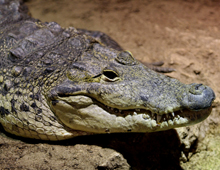Description: Until the 1920s, Morelet’s crocodiles were confused with both the American and Cuban crocodiles. The main distinction is their unusually broad snout. Morelet’s crocodiles have 66-68 teeth. The teeth in the upper and lower jaws are in perfect alignment, which distinguishes all crocodiles from alligators. The fourth tooth, on either side of the bottom jaw, is slightly larger than the other teeth and is visible when the mouth is closed. They are dark grayish- brown, with even darker bands and spots on the body and tail. The dorsal armor is irregular and the neck scales are heavy. The body lacks ventral osteoderms (bony plates in the skin) and is highly valuable for tanning. The iris is silvery- brown in color. The legs are powerful and end in clawed, webbed feet. The strong tail, allows them to swim with powerful thrusts. Juveniles are bright yellow in color with black bands.
Size: This is a relatively small species, usually reaching lengths of 10-14 feet (3.0-4.3 m)
Behavior: Morelet’s crocodiles are generally shy around humans, but 14 feet (4.3 m) specimens may attack. They are active primarily at night, hunting and mating. The daylight hours are spent basking in the sun.
Diet: Juveniles eat small invertebrates and fish. Adolescents feed on aquatic snails, fish, small birds and mammals. Older and larger crocodiles feed on larger prey, such as birds, fish, lizards, mud turtles and domestic animals such as dogs.
Senses: The nostrils are located at the end of the snout; behind the snout are the eyes and behind the eyes are the ears. These three sensory receptors are all located on the same plane, on top of the head, allowing them to stay almost completely submerged underwater, while still being able to see, hear and smell. The eyes have a special eyelid, called a nictitating membrane – a clear eyelid that covers and protects the eyes while underwater.
Communication: Crocodilians are the “loud mouths” of the reptile world. Various sounds, ranging from very low volume coughs and hisses, to high volume roars and bellows are produced by vocal cords located in the throat. Crocodiles convey social messages with sounds, postures, motions, odors and by touch. Communication begins in the egg and continues throughout life. A wide variety of acoustic sounds are also produced. The headslap or jawclap is performed by lifting the head above the water so that the lower jaw is just visible, before swiftly opening then closing the jaws in a biting motion directed at the surface of the water. This makes a very loud popping sound, followed by a resounding splash. Another type, barely perceptible to humans, is the subaudible vibrations, referred to as “infrasound”. The trunk muscles are rapidly contracted just beneath the surface of the water, radiating waves pulse out from the body.
Reproduction: Morelet’s crocodiles have the distinction of being the only North American crocodile to build only mound nests (not mound and hole nests). The breeding season starts before the rainy season. Approximately 20-45 eggs are laid in a mound nest near the water or on floating vegetation. Nests may contain eggs from more than one female. Females guard the nest for 80 days, after which time the eggs hatch. Both parents protect the juveniles from enemies.
Habitat/range: They are found in northern and central coastal Belize, in Mexico and Guatemala. They prefer freshwater and are found mainly in swamps, marshes, rivers and lakes in forested areas. They will also live in brackish waters and in lowland rivers and ponds. Their range overlaps that of the American crocodile.
Status: The Morelet’s crocodile (prior CITES I), is now CITES II for captive populations in Mexico and Belize and has been removed from the ESA; IUCN Conservation Dependent (LR/cd). Data indicates its status has improved to the point that it is not likely to become threatened within the near future throughout much of its range.



